Befriending Bats and Diving Into DNA
Can adding bat houses to a pecan orchard reduce the need for chemical pest control? Noble scientists are joining a quest to find out.
While bats may be one symbol people associate with the scary time of Halloween, we have no reason to fear them and many reasons to be glad they’re around.
By consuming insect pests, pollinating plants and helping disperse seeds, these flying mammals are essential to healthy ecosystems. They’re also a relatively new research topic for the Pecan Strategy Research team at Noble Research Institute, of interest due to their potential as natural pest control for pecan orchards.
That’s why Noble’s Lauren Jones, senior research associate, and Kim Cooper, research associate 2, found themselves observing bat capture, swabbing bat wings for DNA and collecting bat guano this fall at a workshop near San Antonio, Texas. They brought samples and new knowledge back to Ardmore to use in their research into identifying which bat species are roosting in an area and which insect pests they are eating.
“Bats are really interesting animals,” Cooper says, as well as important pollinators and the widest distributors of global seeds, as they sometimes fly 100 miles in a night.
Jones adds, “Some people think they’re scary, but they’re actually quite cute and small and very beneficial.”

Learning about bats and their contributions
The “Join the Nightlife” workshop organized by Merlin Tuttle’s Bat Conservation covered eco-friendly pecan farming, the use of bat houses, and bat survey techniques, including using acoustic detectors to identify bats by the echolocation sounds they make. It opened with attendees watching millions of Mexican free-tailed bats emerge from nearby Bracken Cave, home of the largest bat colony in North America.
“I enjoyed the emergence, and the mist netting was a lot of fun,” Cooper says. “It was a once-in-a-lifetime kind of experience.”
The Noble scientists also watched bats emerge from houses in the Fentress, Texas, pecan orchards of Troy Swift. He built and placed the houses to attract bats as part of his regenerative farming practices and for research into how much impact bats can have in reducing crop pests. It so happens he is neighbors with bat expert Tuttle, with whom he collaborates on both research and constructing bat houses.
Jones, who visited Swift’s orchards with Noble senior research associate Mike Proctor during a similar workshop last year, says it was great to see how many more bats Swift had attracted in just a year’s time, in both orchard test locations. Swift’s houses, designed by Tuttle, are made from thick, rough-sawn, native Texas pecky cypress wood that stands up to the elements and has an excellent surface for bats to climb. Swift salvages the wood after floods and cuts the logs in his lumber mill.
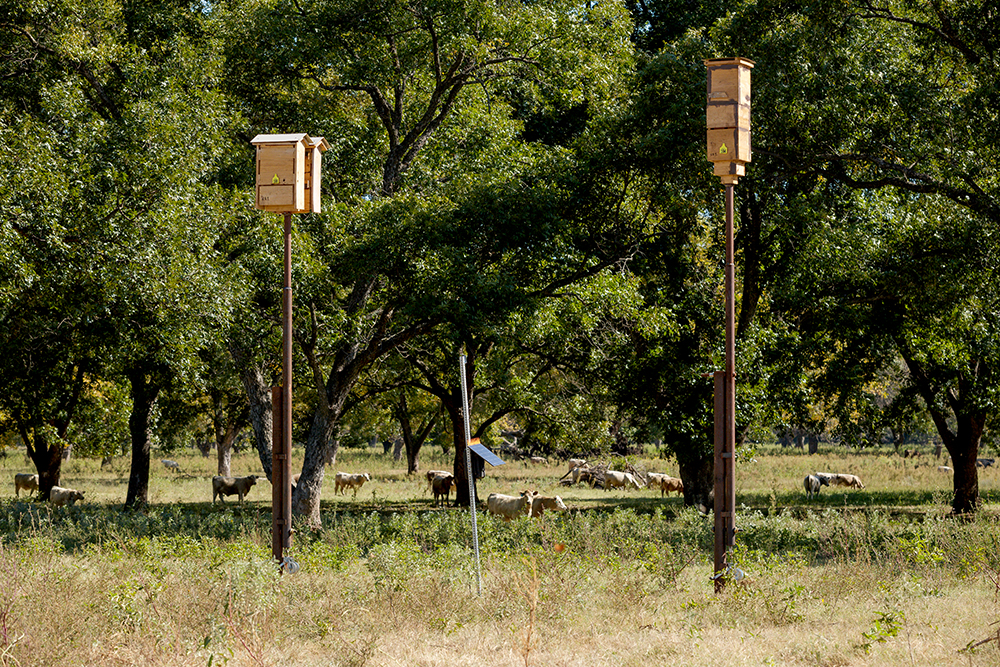
Hoping for bat residents
Nine Swift-built bat houses have been installed in the pecan orchards on Noble’s Red River Ranch and Conrad-McMillan Pecan Farm to add another layer of biodiversity to the ranches and to study the creatures’ impact on pest control. Ranch managers have seen bats in the area, and the hope is that they will come roost in the houses once they see there’s an insect food source to be had in the orchards. Tuttle says it can take years, sometimes, for bats to move into houses.
Jones says that as Noble continues its regenerative efforts, using silvopasture methods of combining the orchards with grazing livestock and adding a wider diversity of forages, the supply of beneficial insects should increase.
“We hope more diverse and flowering forage will introduce some insects that the bats are attracted to,” she says. Then, the bats will also be in residence to feed on the pests that plague pecan trees.
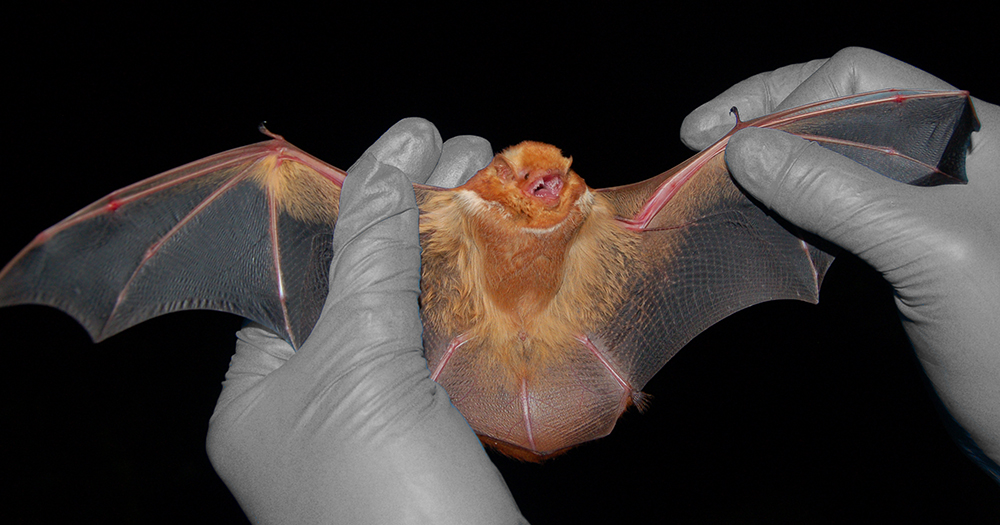
Testing guano to ID bats and pests
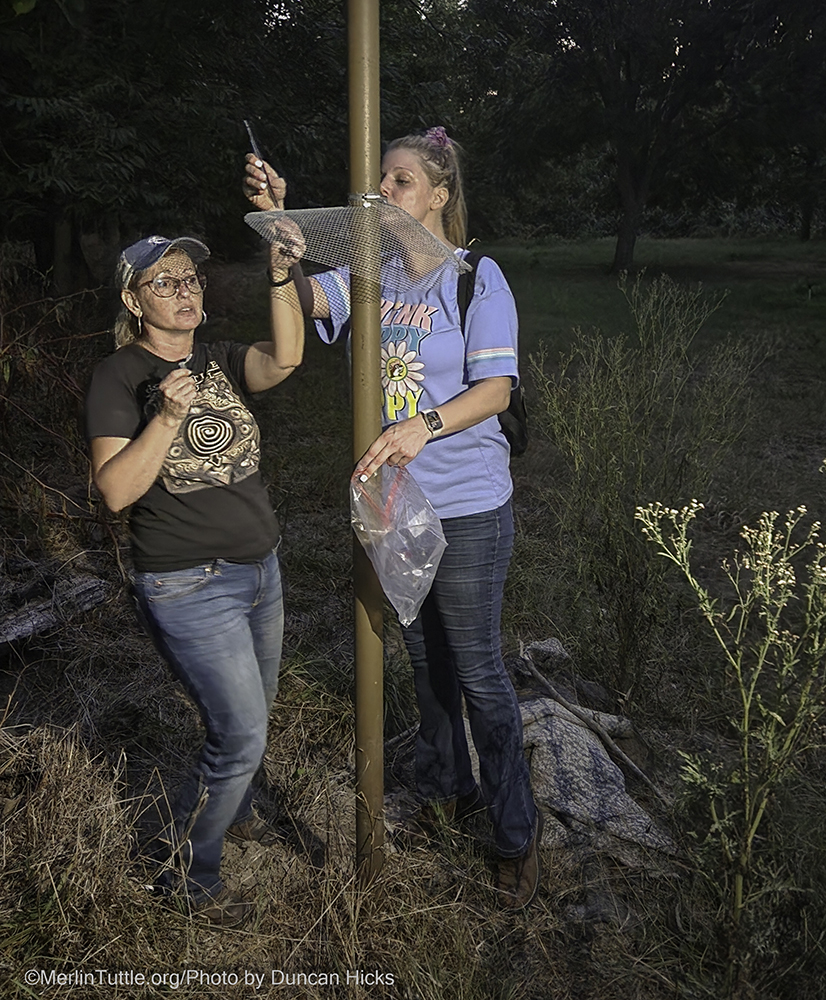
By coordinating with and learning from Tuttle’s and Swift’s research, Jones and Cooper will have the references needed to identify and track both bats and pecan pests. That process started at the workshop, when the researchers there caught bats in thin nets called mist nets, and “identified them with the typical measurements they use when they capture bats,” Jones says.
“And we got to swab the wings of the bats for their DNA, and we’ll use that as a positive control for our PCR (polymerase chain-reaction) testing of the bat species we find here.”
To identify what types of bats move into the Noble bat houses, they’ll collect guano from beneath the houses rather than capture the bats. That will also enable them to learn what specific pecan pests the bats are eating.
While both scientists have experience with DNA extraction and sequencing, this is their first time extracting the DNA “from poop or guano,” they say, laughing.
But the economic damage done by pecan pests and the input costs needed to treat them with pesticides are no laughing matter. Noble will use PCR testing for the presence of several of the most important pests by making specific primers using published sequences of the insect DNA, and will send PCR products made with those primers off for confirmation sequencing.
“We’ll test for the pecan nut casebearer (PNC), which is the first one of the season,” Jones says, as well as for stink bug and hickory shuckworm, which are mid-season pests. She said that among the 100 different insects whose DNA was found in bat guano from Swift’s orchard, one was the pecan nut casebearer. A single PNC moth can lay from 50-150 eggs in just one of the four generations that typically exist in a growing season.
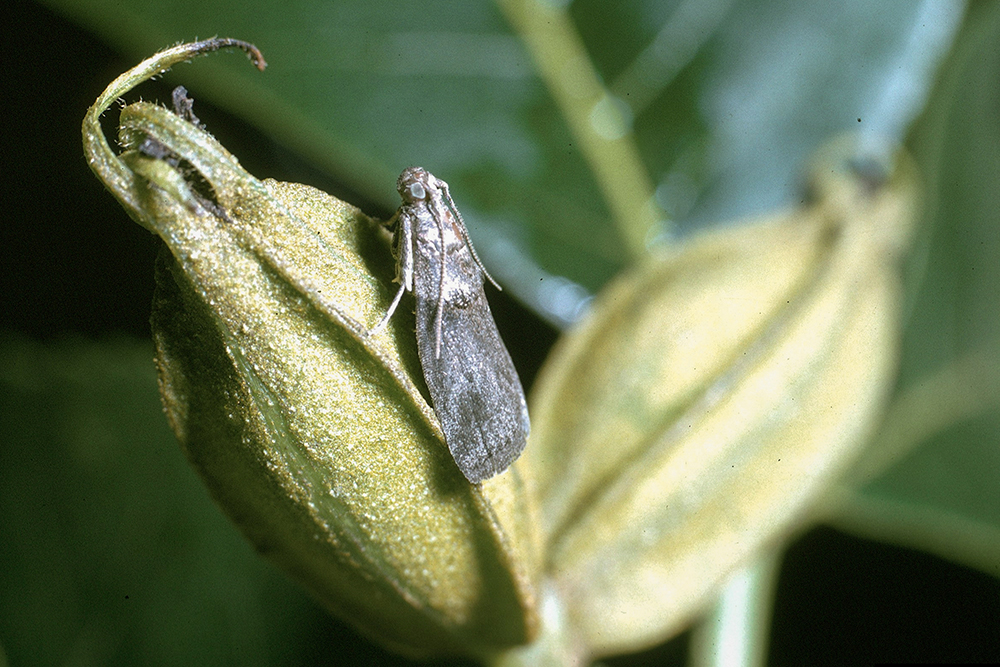
More-sustainable pest control
With up to 200 bats living in a single bat house in an orchard, there’s a lot of potential for them to eat the PNC moths and prevent them from laying their eggs, reducing the number of larvae that hatch and damage pecans. Research has shown that bats eat hickory shuckworm moths as well as stink bugs; and there is more to learn.
“Because these pests have a major economic impact on profitability, we’re trying to have an alternative to sprays, or at least reducing sprays, by hosting bats in bat houses at Noble,” Jones says.
As the Noble Pecan Strategy Research team continues to help producers use and monitor regenerative methods of raising pecans, Jones and Cooper will be ready to do their part, DNA extraction from guano and all, to learn how much help these tiny creatures can be in the orchard.
Hero Photo: Photo by Ann Froschauer/USFWS (https://creativecommons.org/licenses/by/2.0/)
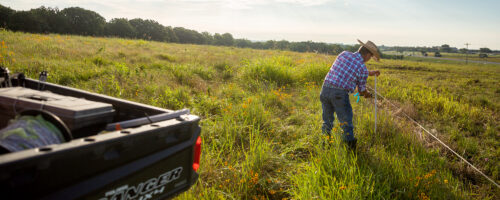
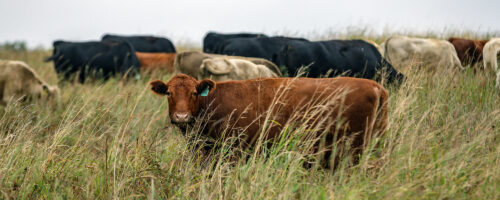
Comment
Leave a Reply
5 comment on: "Befriending Bats and Diving Into DNA""

Terry Beals
October 31, 2023Thanks for this information. Is there a pattern available for one of the bat houses? I have a small orchard n.e. Of Madill. Might the bats help with control of the web worms/tent caterpillars??? that attack many nut trees, persimmons.
Noble Research Institute
November 1, 2023There is a book called, “The Bat House Guide”, that contains design and bat house building information. It is written by Merlin Tuttle. We can’t say specifically about web worms as we are still determining what all orchard pests are being consumed by bats. However, there is a lot of information to indicate that bats have a diet high in moths.
Garrett Nichols
October 31, 2023What design did you use for the bat houses? Im interested in trying this myself.
Noble Research Institute
November 1, 2023We used two designs (Zent’s box, and Rocket box) that are described in the,” The Bat House Guide”, by Merlin Tuttle. Our houses were built using these designs by Swift River Pecans. Troy Swift from Swift River Pecans and Lumber Mill has worked in conjunction with Tuttle to prebuild and sell some of these houses.
John L. Burden
October 31, 2023Would like more information.